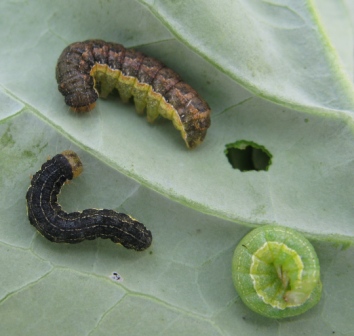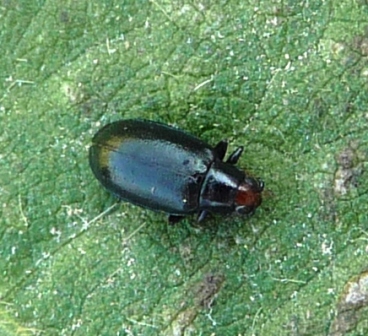Manitoba Insect and Disease Update: Week of August 12, 2013
Bertha Armyworm on Canola: Bertha armyworm have been found at economic levels in some areas of the southwest; in fields near Deloraine, Coulter, Boissevain, Killarney, and Wawanesa. Note that levels of bertha armyworm can vary greatly between fields that are in close proximity. Some fields may have been more attractive to the egg laying females than other fields. So it is necessary to scout each field. Assumptions can not be made based on what nearby fields show.
Although the larvae are nocturnal and mainly feed at night, you can scout for them at any time of day. Just make sure to examine the ground thoroughly, especially under any debris or areas where they may be able to hide. It may be helpful to use a 3-sided frame or a couple of 50 cm long markers to define the area to be sampled. The orange frame in the photo below is a 50cm X 50cm 3-sided frame that can easily slide into the canopy and measures a quarter of a meter square. This is a good size of unit to do counts in; a full meter square will take longer to assess, and you don't want to rush through the counts as the larvae can be good at hiding under debris. So the area measured needs to be examined carefully.


Figure 1. Frame for defining area to do insect counts Figure 2. Different colours of bertha armyworm
Redheaded flea beetles on corn and soybeans: Some have been noting some flea beetles, generally at low levels, on corn and soybeans. This is the redheaded flea beetle (Systena frontalis). They are slightly larger than the flea beetles you are use to seeing on canola, and just one of the 72 species of flea beetles known from Manitoba. They have a broad host range and should not be of economic concern on these crops. Some of their preferred hosts include ragweed, pigweed, lamb's-quarters, and smartweed. Adults are often gregarious, so there may be groups of them on certain plants, while nearby plants are often free of them. Note the red on the head of the flea beetle in the photo below. You may have to use magnification to see this on specimens from the field.

Figure 1, Redheaded flea beetle
European Corn Borer: Is this week too late to be spraying for European corn borer? The short answer is that it likely is. Hatch was underway during the last week in July. It is the 3rd instar larvae that bore into the stalk, after which insecticides will not be effective. The first two instars are normally completed in about 7 to 10 days; this year it may be closer to 10 days because of the cooler weather. Plants can be inspected to see what the levels of 1st and 2nd instar larvae are at, or if egg masses are still hatching. If there is no evidence of high levels of young larvae on the plants than the application of an insecticide would not be an economical decision.
Preharvest Interval Calculator: The Canola Council of Canada has produced a website, which can be accessed at the link below, that will assist in finding the preharvest interval of a pesticide. Recall that the preharvest interval is the number of days that must pass between the application of a pesticide and cutting of the crop (swathing or direct-combining).
Insect Identification Quiz
Question: You may see the occasional beetle like in the picture below while scouting canola late in the summer. What is this beetle?

Answer: These are red turnip beetles (Entomoscelis americana). They are generally not numerous enough to be a concern on canola late in the season. Very rarely they can be a concern when feeding on seedlings early in the season, although this is not common.
Compiled by:
- John Gavloski, Entomologist
Manitoba Agriculture, Food and Rural Initiatives
Phone: (204) 745-5668
Fax: (204) 745-5690. - Holly Derksen, Plant Pathologist
Manitoba Agriculture, Food and Rural Initiatives
Phone: (204) 750-4248
Fax: (204) 745-5690
To report observations on insects or plant pathogens that may be of interest or importance to farmers and agronomists in Manitoba, please send messages to the above contact address.
To be placed on an E-mail list so you will be notified immediately when new Manitoba Insect and Disease Updates are posted, please contact John Gavloski at the address or numbers listed above.
